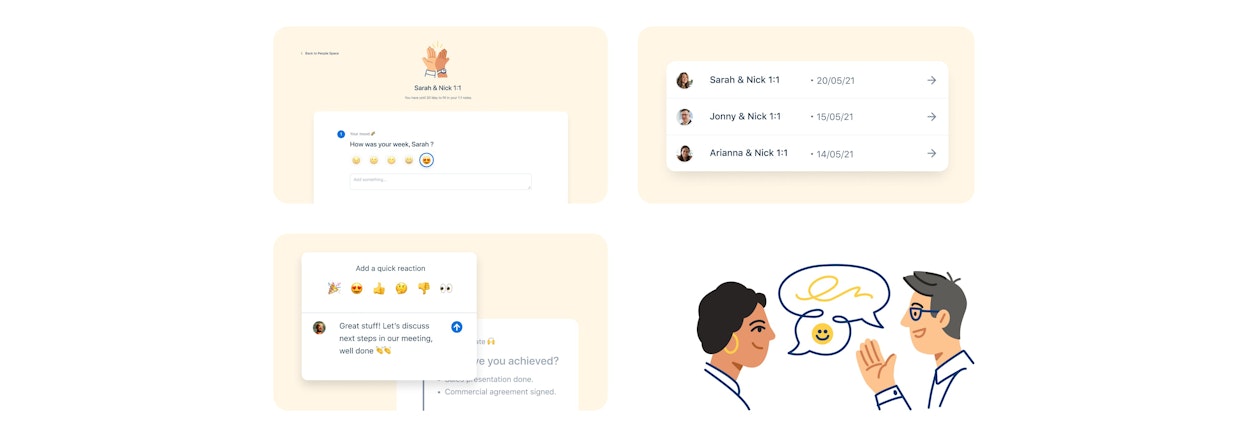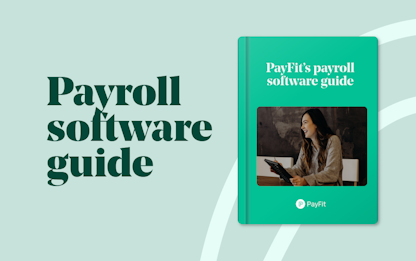- Blog
- |People management
- >Employee wellbeing
- >1:1 meetings
Five key points to ensure successful 1:1 meetings


Managers and employees meeting weekly — it’s a good thing, right?
In theory, yes.
If you’re a manager, a weekly 1:1 with each member of your team provides an opportunity for you to discuss topics of interest with them.
For an employee, this meeting offers a chance to raise issues with you that they may feel unable to do at any other time.
The success of any meeting is dependent on both parties preparing things in advance. Very few meetings work when attendees rock up without any idea about the subjects they wish to discuss.
A 1:1 is no different. In fact, there’s an argument to say that when meetings are between just two people, the need for organisation and preparation is heightened even further.
So, how can managers and employees look to make the most out of their weekly 1:1s?
In this article, we look at five key points that managers may wish to consider and explain how PayFit can help support the success and effectiveness of these weekly meetings.
1. Structure
The structure of your 1:1 meeting is imperative in ensuring that the meeting is impactful for all parties.
Having a consistent schedule — e.g. every Tuesday at 10 AM — will allow for a better follow-up and a more fluid and efficient meeting. For example, you and your team member can get into a routine whereby you prepare all your notes and topics to discuss the night before.
The meeting itself should also follow a particular structure that allows you and your employee to flow from one topic of conversation to another relatively seamlessly.
2. Employee wellbeing
Prior to getting into the more operational topics, it’s always a good idea to check in with your employee and ask them about their general wellbeing.
You may wish to ask them some of the following questions:
How do you feel?
Has your week been a good one? If not, why not?
Is there anything impacting your wellbeing that you would like to share with me?
Having these sorts of conversations can undoubtedly help build and strengthen the manager-employee relationship.
Once you’ve addressed these issues, you can move on to discussing more work-related subjects. You may wish to ask further questions to help you better gauge their workload.
How’s your current workload? Is it manageable, or do you need to have further support?
Do you have any blockers? Would you like me to try and iron these out for you?
It’s crucial that you understand the challenges that your team member is facing. But, equally, it’s vital that they know that you’re there to provide solutions to blockers that may exist within the company.
3. Projects
When discussing the projects that your team member is working on, start by focusing on those that are the highest priority.
Ideally, this part of the 1:1 will be primarily led by the employee. They will be best placed to discuss their top priorities and the status of projects that they’re involved in.
You may wish to encourage your employee to begin this part by providing an overview of projects before moving on to the current and possible challenges.
It’s probably a good idea to end this part of the 1:1 by running through the following steps, evaluating the priorities for the coming week, and discussing deadlines that both you and your employee will be working towards.
4. Anything else...
Before the end of the meeting, you can ask your team member whether there is anything else they wish to discuss.
It may be something as simple as an annual leave request, a discussion about possible career development, or even an explanation of a particular company policy.
There may not be something worth discussing each week; however, it’s always a good idea to leave the floor open and to empower your team member to raise issues with you.
5. Clear communication
While this may sound like a bit of a given, you’d be surprised about how much time can be wasted through a lack of clear communication.
At the end of each meeting, it is often a good idea to recap all the things you’ve discussed and ensure that you’re both completely aligned on the next steps that need to be completed before you reconvene in a week’s time.
If there seems to be a misunderstanding for any reason, it is probably worth asking your team member whether or not they find your way of communicating easy to understand or if the 1:1 setup you use is not working for them.
There is little point in organising weekly 1:1s if what is discussed is not then progressed or implemented. Consequently, by adding this step, you can help ensure that your 1:1 has been worthwhile.
PayFit’s 1:1 feature
At PayFit, we’re big fans of 1:1s and firmly believe that regular 1:1 meetings are an invaluable part of the manager-employee relationship.
In fact, we’re such big advocates, we’ve gone so far as to build our very own 1:1 feature to support our existing HRIS module.
Through this feature, we hope to bridge the gap between managers and employees, encourage clearer communication channels, increase transparency, and help boost overall employee engagement.
Did you know?
Clear and regular communication can result in a 300% increase in employee motivation and productivity.
What are the benefits of using PayFit’s 1:1 feature?
When setting out on this project, we weren’t looking to reinvent the wheel. After all, a 1:1 isn’t a particularly complex process in itself. When broken down, it is just a meeting between two people.
Nevertheless, the success of a 1:1 is often dependent on its organisation and structure. All too often, 1:1s take on a form of their own whereby both managers and employees flitter from one subject to another.
Consequently, when building this feature, our product team was aware that they had to construct something simple, collaborative, customisable and centralised.
Our feature doesn’t restrict managers to a particular format; instead, it allows them to create a routine that suits them and those they manage. For example, it only takes a manager a matter of minutes to set the time, date and regularity for an employee’s 1:1 schedule. Furthermore, they can also set personalised questions for each employee they manage.
Once this has been organised, the employee is then notified the day before their meeting to answer the questions that they’ve been set.
When answered, managers are subsequently notified and can comment or provide emoji reactions to their team member’s answers before the meeting takes place.
Both managers and employees can view their most recent and all their previous answers within their respective portals. This means that both parties can view the topics they’ve previously discussed and easily track the progress of projects.

How does the PayFit 1:1 feature work?
1. The manager initiates the conversation and customises the questions.
2. The employee is sent an automated email inviting them to answer questions from their admin space. The answers are then shared with the manager before the 1:1 taking place.
3. The manager can view the responses, comment and add feedback.
4. Manager and employee meet to discuss and review the 1:1’s preparatory notes.
Through this simple yet effective process, we believe that both managers and employees can benefit equally through better engagement, bridging the gap between them, encouraging expression of thoughts and ideas, and providing a platform where support can be sought if necessary.
Interested in finding out how PayFit can help support your business’s payroll and HR processes? Why not book a demo with one of our product experts?


The 2024 UK National Living Wage - An Employer’s Guide

The Cost Of Recruitment In The UK - What You Might Not Know

UK National Insurance Changes for January 2024

End Of Tax Year 2023/2024 - Eight Key Changes For 24/25

Strategies to Reduce Employee Turnover

